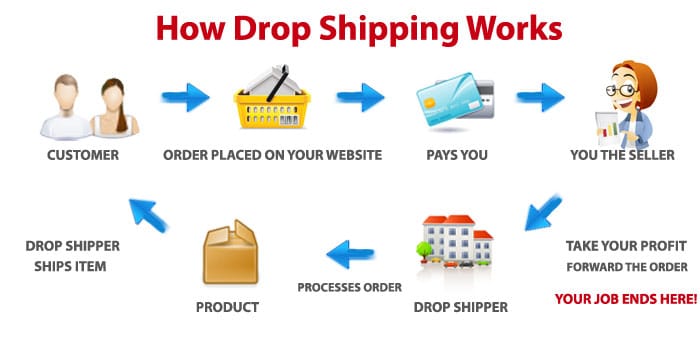Updated on May 10, 2024: Enhanced the article by incorporating insights on the advantages and disadvantages of dropshipping, including factors such as lower profit margins, supplier dependency, and customer service challenges. Additionally, provided detailed steps for initiating a dropshipping venture in Kenya, along with practical tips for selecting a niche, finding reliable suppliers, and promoting the online store effectively.
Dropshipping in Kenya is a top e-commerce business that allows entrepreneurs to create a virtual store and sell products online without having the said products in stock.
If you would like to get an online business from scratch by creating a virtual store, without having to spend money on product inventory and without having to pack and send goods by mail? Then, you have landed at the right place.
You can display the product details on your eCommerce website (Which we can develop for you) and forward all purchase orders directly to the suppliers, who are in charge of sending your request directly to your customers.
While you, as the online retailer, can eliminate inventory holding costs and the risk of getting stuck with products that did not sell.
What Is Dropshipping?
Dropshipping is a retail fulfillment method where a store doesn’t keep the products it sells in stock. Instead, when a store sells a product, it purchases the item from a third party and has it shipped directly to the customer. This means you don’t have to worry about inventory management or shipping logistics, making it an attractive option for new entrepreneurs.
Dropshipping is like being a matchmaker between buyers and sellers. You have a website where people can buy things. When someone orders from your website, you tell the supplier to send the item directly to the buyer. You don’t need to buy the items in advance. You just add a bit extra to the price the supplier charges you, and that’s how you make money.
So, you don’t pay the supplier until after you’ve already got the money from the buyer. This way, you’re not using your own money to buy the products you’re selling. It’s easiest to do dropshipping online, through your own website or on big sites like Jumia or Amazon. There are special tools that help connect sellers like you with suppliers, so you can handle payments, orders, and shipping smoothly.
How Drop Shipping Business in Kenya Works
But before you start, you should know the seven steps involved in creating an online drop shipping business:
1. Choose Your Niche
The first step in starting a dropshipping business is to choose a niche. A niche is a specific segment of the market that you’ll target with your products. It’s essential to select a niche that you’re passionate about and that has demand in the Kenyan market. Research popular trends, products, and competitors to identify a profitable niche.
2. Find Reliable Suppliers
Once you’ve chosen your niche, you’ll need to find reliable suppliers to source your products from. Look for suppliers who offer dropshipping services and have a good reputation for quality and reliability. You can find suppliers through online marketplaces like Alibaba, AliExpress, or through direct contact with manufacturers.
3. Set Up Your Online Store
Next, you’ll need to set up your online store. Choose an e-commerce platform like Shopify, WooCommerce, or Magento that supports dropshipping. Customize your store with a professional design and user-friendly interface. Make sure to optimize your store for mobile devices, as many Kenyan consumers shop on their smartphones.
4. Import Products And Set Prices
Once your store is set up, it’s time to import products from your chosen suppliers and set prices. Be sure to factor in the cost of the product, shipping fees, and your desired profit margin when setting prices. It’s also essential to write compelling product descriptions and take high-quality photos to entice customers.
5. Promote Your Store
Now that your store is ready to go, it’s time to start driving traffic and generating sales. Use a combination of digital marketing tactics such as social media marketing, influencer partnerships, search engine optimization (SEO), and email marketing to promote your store and attract customers. Consider running special promotions or discounts to incentivize purchases.
Learn how to ship from Amazon to Kenya
6. Manage Customer Service And Fulfillment
As orders start rolling in, you’ll need to manage customer service inquiries and fulfillment. Be responsive to customer questions and concerns, and work closely with your suppliers to ensure orders are processed and shipped on time. Providing excellent customer service is crucial for building trust and repeat business.
7 Analyze And Adapt
Regularly analyze your sales data and customer feedback to identify areas for improvement and adapt your strategy accordingly. Monitor your profit margins, customer acquisition costs, and conversion rates to ensure your business remains profitable and sustainable in the long run.
Advantages Of A Dropshipping
- Low Startup Costs – Traditional businesses require significant capital to invest in inventory, storage space, and other overhead expenses. With dropshipping, you can start your business with minimal upfront costs. Since you don’t need to purchase inventory in bulk, you can allocate your funds to other essential aspects of your business, such as marketing and website development.
- No Inventory Management – Managing inventory can be a time-consuming and costly aspect of running a business. With dropshipping, you don’t need to worry about stocking or storing products. Your supplier handles inventory management, including restocking and storing products. This frees up your time and resources to focus on other aspects of your business, such as customer service and marketing.
- Flexibility – Dropshipping offers flexibility in terms of location and working hours. You can run your business from anywhere with an internet connection, whether it’s from home, a coffee shop, or while traveling. Additionally, since you’re not tied to a physical store, you have the flexibility to set your own working hours and manage your business according to your schedule.
- Wide Product Range – With dropshipping, you have access to a vast range of products without the need to purchase or store them yourself. You can easily add new products to your online store and test different niches without the risk of holding excess inventory. This allows you to cater to a diverse range of customer preferences and adapt to changing market trends quickly.
- Less Risk – One of the significant advantages of dropshipping is that you only purchase products from your supplier after you’ve made a sale and received payment from the customer. This significantly reduces the risk of holding unsold inventory and minimizes the financial risk associated with traditional retail models. Since you’re not investing your own money in inventory upfront, you have more flexibility to experiment with different products and marketing strategies.
- Scalability – Dropshipping is highly scalable, allowing you to grow your business without the limitations of physical inventory or storage space. As your business expands, you can easily add new products, scale up your marketing efforts, and reach a broader audience without the need for additional infrastructure or resources. This scalability makes dropshipping an attractive option for entrepreneurs looking to build a successful and sustainable online business.
- Focus on Marketing – With the operational aspects of your business, such as inventory management and order fulfillment, handled by your suppliers, you can focus more on marketing and growing your business. By investing time and resources into marketing strategies such as search engine optimization (SEO), social media marketing, and email marketing, you can attract more customers, increase sales, and build a loyal customer base for your dropshipping business.
Disadvantages Of Dropshipping
- Lower Profit Margins – Since you’re not buying products in bulk, your profit margins per sale may be lower compared to traditional retail models. This is because you’re adding a markup to the supplier’s price, which can sometimes be slim, especially if you’re competing with other dropshippers selling the same products.
- Supplier Dependency – Your business’s success relies heavily on your suppliers’ reliability and efficiency. If your supplier runs out of stock or fails to fulfill orders promptly, it can lead to delays in shipping and customer dissatisfaction. You need to choose suppliers carefully and maintain good communication to minimize the risk of such issues.
- Limited Control Over Product Quality And Shipping – Since you’re not handling the products yourself, you have less control over product quality and shipping times. If a supplier sends a defective product or ships it late, it reflects poorly on your business, even though it’s not directly your fault. Providing excellent customer service and choosing reputable suppliers can help mitigate these risks.
- Increased Competition – The barrier to entry for dropshipping is relatively low, leading to a saturated market with lots of competition. It can be challenging to stand out among other dropshippers selling similar products. To differentiate yourself, you’ll need to focus on offering unique products, providing exceptional customer service, and implementing effective marketing strategies.
- Complexities in Inventory Management – While not having to manage inventory is a benefit, it can also be a disadvantage in some cases. Without visibility into stock levels, you may accidentally sell out-of-stock items or face backorder issues. Keeping track of product availability and coordinating with suppliers requires careful monitoring and organization to avoid customer dissatisfaction.
- Customer Service Challenges – As the middleman between customers and suppliers, you may encounter challenges in managing customer inquiries, returns, and refunds. Customers may expect you to provide support and assistance, even though you’re not directly handling the products. Clear communication with customers and efficient resolution of issues are essential to maintain a positive reputation.
- Shipping Costs and Times – Shipping costs and delivery times can vary depending on the supplier’s location and shipping methods. Customers expect fast and affordable shipping, so delays or high shipping fees can lead to dissatisfaction and lost sales. Negotiating favorable shipping terms with suppliers and offering transparent shipping options to customers can help mitigate these challenges.
Note: By being aware of these disadvantages and implementing strategies to address them, you can overcome obstacles and build a successful dropshipping business in Kenya.
Popular Dropshipping Items
- Jewelry
- Phone cases
- Lingerie/Underwear
- Dog Clothing
- Toys and Games
- Fitness Equipments and Apparel
- Kitchen Supplies
- Home Decorations
Best Platforms For Dropshipping In Kenya
Shopify
Shopify is a popular ecommerce platform that offers a user-friendly interface and robust features for building and managing online stores. It provides various integrations and apps specifically designed for dropshipping, making it easy to connect with suppliers, manage orders, and automate processes. Shopify also offers reliable payment gateways and customizable storefronts, allowing you to create a professional online presence for your dropshipping business in Kenya.
Jumia
Jumia is Africa’s leading online marketplace, offering a wide range of products across various categories. As a seller on Jumia, you can leverage its existing infrastructure and customer base to reach millions of potential buyers in Kenya and other African countries. Jumia provides seller tools and support to help you manage your dropshipping business effectively, including order management, shipping logistics, and customer service.
Amazon
While Amazon may not have a dedicated marketplace for Kenya, you can still use its platform for dropshipping by selling to international customers. Amazon’s vast reach and reputation can help you access global markets and increase your sales potential. However, it’s essential to consider logistics and shipping requirements when dropshipping on Amazon, as international shipping can be complex and costly.
WooCommerce
WooCommerce is a customizable ecommerce plugin for WordPress, allowing you to build and manage an online store within your WordPress website. It offers various extensions and integrations for dropshipping, including plugins that connect you with suppliers and automate order fulfillment. WooCommerce is a flexible option for dropshipping in Kenya, allowing you to tailor your store to meet your specific needs and preferences.
Facebook Marketplace
Facebook Marketplace is a platform where users can buy and sell items locally. While it may not be as sophisticated as other e-commerce platforms, it can be a useful option for dropshipping in Kenya, especially if you’re targeting a local audience. You can create listings for your dropshipping products and reach potential customers within your community.
Ultimately, the best platform for dropshipping in Kenya depends on your specific business needs, target audience, and marketing strategy. It’s essential to research each platform thoroughly and consider factors such as fees, features, and audience reach before making a decision. Additionally, you may choose to use a combination of platforms to maximize your sales and reach a broader audience.
FAQs – The Blueprint For Dropshipping In Kenya
How can I start dropshipping in Kenya?
To start dropshipping in Kenya you have to formally register your business, and identify the right CMS and dropshipping plugin, or a marketplace where you can host your storefront. With that done, you have to follow these steps:
- Identify your target niche
- Pick the right product
- Find reliable suppliers
- Choose a payment gateway
- Acquire traffic
- Upsell
Is dropshipping a good business model?
Dropshipping is a good, low-risk business model that can be quite profitable if you find a good niche and the right products to sell. The fact that you don’t have to carry inventory or handle the shipping removes much of the regular costs of starting a retail business but it does mean competition can also be high.
How do I handle customer service and returns in my dropshipping business?
Customer service is a crucial aspect of running a successful dropshipping business. You’ll need to promptly respond to customer inquiries, address concerns, and handle returns or refunds efficiently. While you’re not physically handling the products, you’re still responsible for providing a positive customer experience. Establish clear communication channels and work closely with your suppliers to resolve any issues that may arise.
Conclusion on Dropshipping in Kenya
By integrating the drop-shipping model in your online business, you can forget the issues of stock movements and trips to the post office; your suppliers will do everything.
Following the correct steps to set up your dropshipping in Kenya business, you can save your time and effort to make your business start and proliferate.
And now, if you want to learn how to put all these steps into practice and systematically, as well as meet reliable suppliers, even if you have no experience, I know something that can help you.
You can learn from a professional who understands almost everything about this business and will explain in a practical and all that you should do.





Sounds a great idea if such can work.
Would be highly interested in checking if further with you.
Hi. Thanks for the useful info. Have started but stuck. Can you assist with pricing? How do I price my products? Is it the price from the supplier when I import the product to my store or I add my mark up?
Hey Priscilla and Faustine,
I can help you on drop shipping business.I usually make 300000 plus every month.If you are interested you can email me at this email stephenkibe691@gmail.com.so as to learn more.
Thank you
Steve, how do you handle the payment side then?
What payment gateways do you use and how do you tackle the legality of dropshipping if you want to keep it on an individual level rather than getting a company registered and all ??
Hey Mohammed
Contact me through my email stephenkibe691@gmail.com
I will help you.
Thank you.
I would like to start immediately if you can assist
Im Jacinta, im interested. I have the items i want to sell. Kindly assist on a good dropshipper
I am interested, I want practical help.
Great article. If anyone is starting out i am also a begineer we can network. Cmuthomi48@gmail.com
Hi great people? Somebody help I am very interested
sounds great…interested
Hey how is it going with dropshipping
Here is the meeting space for KE DropShipping;
https://chat.whatsapp.com/GOgIAKsu8Dc0r40oLuwl1q
Happy & Profitable selling!
I am also very interested.
jonkeziah@gmail.com. Any guidelines.
hello, how can i locate legit suppliers